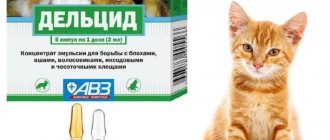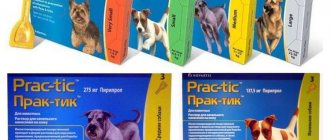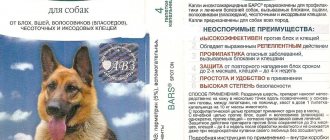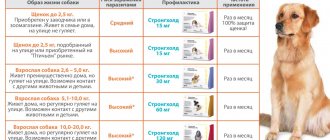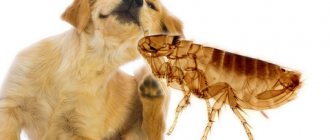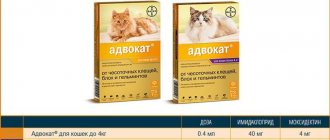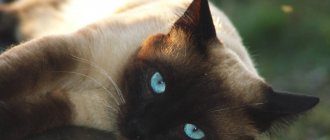No cat is immune from the danger of parasite infection. It’s not at all difficult for your pet to pick up fleas and ticks; just go for a walk in the yard, sit on the balcony in warm weather, or play with another animal that you brought to visit. An infected cat not only becomes susceptible to various infectious diseases and becomes irritable, but can also infect the owner. To avoid this, you should not neglect regular treatment of your pet for parasites.
Composition of flea drops
On the modern market, there is a very large selection of flea drops and there is no single composition for them. But the following will list the main substances that are used in these drugs:
- permethrin, phenothrin, etofenprox - pyrethroid insecticides of the 2nd generation, derivatives of dimethyl-cyclopropane-carboxylic acid;
- imidacloprid is an insecticide belonging to the group of neonicotinoid compounds (acts exclusively on fleas);
- fipronil and pyriprole are insecticides of the phenylpyrazoles group;
- diazinon is a phosphorus-containing insecticide.
The active ingredients S-methoprene and pyriproxyfen, which some drugs contain, differ in their pharmacodynamics. These are juvenile insecticides - synthetic analogues of a special juvenile hormone of insects that regulates the stages of their development. When these substances enter the body of a parasitic insect, a disruption of its normal development at the larval stage occurs, leading to death.
Requirements for the product for skin application of spot-on against fleas
To choose the right drug for a kitten or adult animal, you need to consult a doctor. Spot-on facilities must meet the following requirements.
Efficiency.
The drops are really effective against most skin parasites. They help to quickly get rid of fleas without harming the animal.
Safety.
The “toxic” substances in the drugs only affect pests. They are practically safe for cats' health. But, like any medicine, spot-on drops have contraindications, so before using the product you should consult a specialist.
Versatility.
Spot-on products are suitable not only for the complete destruction of insects. The drug will prevent infection if you go with your pet to nature, becoming an excellent preventive measure. In addition, many products have a complex effect, also protecting against ticks, lice, lice, and some against intestinal parasites.
The principle of action of the drugs
Flea drops act exclusively on the animal’s skin and do not enter the bloodstream. After you have dropped the drug on your pet, you will not be required to take any additional action. The main active ingredients of the drops are themselves distributed over the skin, hair follicles and fur of the animal. These drugs act as neurotoxins on fleas.
The parasites are simply paralyzed and the fleas soon die. In general, fleas should die within a maximum of 24 hours after applying the drops. Bathing your pet can interfere with this; the drug will simply be washed off with water, so keep your pet away from water for 48 hours after use. And keep your pet away from children, the chemicals may harm the child.
Rules of application
Before applying the medicine, you must carefully examine the cat/dog's skin for rashes and wounds:
- drops are applied to the withers at one point, for greater effectiveness - along the ridge at several points, avoiding contact with the fur if possible. A small amount of the drug is applied under the neck, at the base of the skull, distributed over the back;
- The cat or dog should not be bathed 24 hours before and after treatment, so as not to damage the fatty layer of the skin. Compliance with this rule is mandatory; if ignored, treatment will have to be repeated;
- droplet protection weakens over time: the highest protection profile is observed in the first 7 days, after three weeks the containment indicator decreases by 10 points, after 4 - by 25-30 points.
Benefits of drops
In addition to fighting fleas, the drops also resist any ticks (ixodid, ear, subcutaneous and scabies), as well as lice-eaters. Flea drops can prevent your pet from becoming infected with heartworms.
Flea drops have proven themselves to be effective medications. In general, one application of the drug on an animal should be enough to protect it from fleas for a period of 1 or 2 months.
The effect of the drop begins 20 minutes after use. The drops are also safe if used correctly, but precautions should be taken to avoid overdosing.
Flea drops are convenient to use; as a rule, they are packaged in a small pipette, which is designed for one use. Using a pipette, you can freely apply drops to any part of the animal's fur.
When can you wash your cat after applying the drops?
You can wash your cat 2-3 days before the procedure and 2-3 days after it. This is necessary so that a protective fat layer has time to form on the animal’s body before applying the drops, and so that the medicine has time to be absorbed into the skin after the procedure.
The duration largely depends on the composition of the chosen product and the mechanism of its action on parasites. So water-based products are absorbed in 1-2 days, while oil-based drops need 3 to 5 days.
Attention! The only reason to wash your cat after the procedure without waiting until the due date is the symptoms of an allergic reaction (redness of the skin, itching, scratching).
Effective flea drops for cats: review and rating
Beaphar (Bifar)
The safest flea drops. The drug is made in the Netherlands and does not contain aggressive components; even if the pet licks some of the drug, there will be no consequences for it. These drops are effective for half a month or a month. Suitable for kittens, cats, cats and even recently ill and weakened animals. Beaphar drops have proven themselves to be one of the best on the market.
Hartz UltraGuard OneSpot (Hartz Ultragard)
Made in the USA, they are considered effective because they contain methoprene, a substance that does not spare fleas. Drops are on sale in several versions. There are different dosages of the drug, which are distributed according to the age of the animal.
Manufacturers assure that fleas disappear within the first day after use. Due to their strong effect, these drops are highly not recommended for use on kittens under three months old, as well as on sick and weak animals. The advantage is that they are not so easy to wash off with water; even if the animal gets caught in the rain, you won’t have to use the drops again.
Advantage
It is considered a rather strong drug, but despite this, it is a safe remedy. The substance used as a basis is imidocloprid, which does not have mutagenic, sensitizing or carcinogenic effects. It also does not cause allergies in animals. Still, drops should not be used on kittens that are no more than two months old. Advantage is afraid of water and if the animal has been in contact with it, the drops will need to be reapplied.
Inspector
Inspector drops are a universal preparation. They have both healing properties and are used as prophylaxis. Its active components (fipronil and moxidectin) cope well even with advanced stages of flea infestation.
They also work against lice-eaters, demodectic and ixodid ticks. After use, the animal must not be washed for four days. The drops last for about 2 months. But there is one limitation: Inspector cannot be used on pets whose weight is less than 4 kg.
Frontline
French-made flea drops, made on the basis of fipronil. The product can be purchased in pipettes; there are different dosages. Drops are used against fleas, helminths and ear mites. Frontline can be used if the animal is more than two months old. In the area where the drug is used, the fur may turn a different color. According to the manufacturers, the drops are effective for about one and a half months.
Leopard
Drops made in Russia. Made from the active ingredient fipronil. Fipronil is a safe component and will not cause any particular harm to your pet. Despite its safety, Bars is a fairly strong drug and fights fleas well.
The product is also used as a preventive measure. It has a very strong smell - this creates an even better effect and repels parasites. The doses of drops used depend on the weight of the animal. There is a separate version of the drug for kittens one and a half months old, which has a more gentle concentration of the active substance.
"Celandine"
The drops are made on the basis of two substances - fipronil and permethrin (in a ratio of 1 to 5). Celandine is suitable for kittens from 2 months. The drops begin to work immediately after application and the effect lasts from one and a half to two months. Celandine destroys not only formed fleas, but also their larvae. There is no connection between the celandine plant and the drug “Clandestine”. The name of the drops only reflects its effect.
Stronghold
A frequently used drug, the preventive effect of which lasts 30 days. For adult animals, the contents of a whole pipette are used, and for kittens – 6 ml per kilogram of body. Within a few hours after the procedure, your pet can be bathed, petted and hugged. One package contains three pipettes.
Bayer Advantage for kittens and cats up to 4 kg
An effective drug whose active ingredient is imidacloprid. The component provokes paralysis of blood-sucking insects, causing them to become unviable. The drug is low-toxic and is suitable for cats weighing less than 4 kilograms and kittens after 10 weeks of birth. The effect lasts for about a month.
RolfСlub 3D for cats up to 4 kg
The product provides protection against fleas, ear mites, lice eaters, mosquitoes, and midges. The preventive effect lasts about a month. The drug is quite effective, but at the same time practically harmless to the animal.
Bayer Advantage for large cats
The concentration of the active substance allows the drug to be used on cats weighing more than 4 kg. In addition to eliminating fleas on the animal itself, the foci where the pet sleeps are also destroyed. These drops are not afraid of water and work even after swimming. The drug is hypoallergenic and lasts up to a month.
Inspector Total K
Due to the combination of insecticides such as fipronil and moxidectin, the drug is effective for 2 months after application to the skin. Suitable for cats weighing less than 4 kg and kittens weighing 1 kg, but not younger than 7 weeks. The drops have a slight odor.
Preparations for pregnant and lactating cats
If your cat is pregnant or nursing kittens, then you need to choose flea drops wisely and use only the recommended doses to avoid disruption of fetal development. For such cats, hypoallergenic, non-toxic drops are suitable. These drops include:
- Frontline;
- advantage;
- Stronghold;
- Inspector.
How do they affect cats and kittens?
Flea drops for cats have various pharmacological properties. Some of them repel parasites through a distinct unpleasant odor. The use of such drug options is recommended to prevent infection.
Those that have a more toxic effect kill larvae and adult parasites through direct contact or when blood is consumed by the arthropod.
The principle of action of medications is as follows: the medicine is slowly absorbed, gradually localizing in the ducts of the sebaceous glands. It is thanks to this feature that it can remain effective for several weeks or months.
The larvae that appear after treating the animal die within a few hours; the adults simply leave the cat’s fur. Most often this is observed within one day after the procedure for applying the medication.
Why don't flea and tick drops work?
Drops may not work if you used a drug that is afraid of water and the animal was caught in the rain, for example, and the drops had not yet had time to be absorbed and spread throughout the pet’s fur and skin, or you used a smaller dose than recommended. Or these drops are simply not effective and you should try to use other brands, for example, those given in this article.
And you should not expect that all parasites will die in the first day after using the drops. Even despite the assurances of the manufacturers, all fleas can die only on the second or third day.
Precautionary measures
- Although celandine drops are not overly toxic, it is still poison, so the following safety precautions must be observed when using the drug.
- The person performing the procedure on the cat must wear special gloves that protect the skin of their hands.
- Avoid contact of the drug with the eyes or any other mucous membranes of both yourself and your pet.
- To protect yourself from celandine entering the body, you should not eat, smoke or drink during the procedure.
- If the drug is ingested, gastric lavage should be performed.
- After the procedure, it is enough to wash your hands with soap or disinfect them.
- An empty container of celandine must be disposed of.
How to use drops for cats
How to put drops on the withers
This is a fairly effective method in the fight against fleas; you will need to place the cat next to you and try to calm it down so that it does not twitch. Next, spread the fur on the animal’s withers and drop the recommended dose of the drug onto the cat’s skin.
Contraindications to the use of drops
Although most modern flea drops are non-toxic and hypoallergenic, there are still certain contraindications to the use of the drugs.
- It is necessary to take into account the age of the cat; most drops cannot be used if the cat is no more than one and a half to two months old.
- It is not recommended to use drops if the animal is sick at this moment or is exhausted. In this case, it is best to contact a veterinarian, only he will be able to select flea treatment for such an animal.
- The use of flea drops is also excluded if the cat is pregnant or nursing her offspring. This can cause serious harm to the fetus and can even lead to miscarriage. There are a limited number of manufacturers whose drops can be used by pregnant and lactating cats; they were listed earlier in the article.
- Some cats cannot tolerate certain components of flea drops; low-toxic and hypoallergenic preparations are suitable for them.
- It is also not allowed to apply the drug to those areas of the skin that have wounds.
If you ignore the above contraindications, this can cause serious harm to your pet, even to the point of death. And if there are any, then it is best to contact a veterinarian, he will select an alternative to flea drops.
Overdose of flea drops
If you use more drops than recommended, your cat may overdose on the drug. This can be recognized by the following signs:
- excessive salivation;
- severe vomiting;
- muscle cramps;
- the cat becomes lethargic and may refuse to eat.
When used correctly, flea drops will not harm your cat's health. You will help your pet quickly get rid of parasites and regain health.
How can you tell if your cat has fleas or ticks?
If the cat is domestic, then it is extremely important to immediately notice that it has been attacked by blood-sucking parasites. Otherwise, they will not only move on to other animals living in the house, but will also damage the upholstery, linen and belongings of the owner. Therefore, if the following signs appear, you should either check the animal yourself for the presence of fleas, or take it to the veterinarian:
- The appearance of scratches, redness, protruding blood, irritation or inflammation on the skin;
- Detection of small dark spots in the fur, similar to dandruff;
- The fur lost its well-groomed appearance, stopped shining, and its loss became more frequent;
- The animal has become irritable, aggressive, and constantly itches.
It should be understood that even one flea that appears on a cat will not disappear by itself. Such parasites tend to multiply quickly, and they can also infect the animal with worms.
Signs of ticks in a cat are as follows:
- A significant increase in body temperature and, as a result, complete apathy, reluctance to leave your bedding and eat food;
- Dehydration and sudden weight loss;
- Vomiting and diarrhea, accompanied by cough and shortness of breath;
- Yellowing of the skin;
- The mucous membranes turn from pink to gray or white;
- The hair begins to fall out and redness of the skin is observed in bare areas.
How to use drops for dogs
Where to put flea drops on a dog?
Usually flea drops are placed on the dog's withers. Whether you need to rub in the drops or not depends on the drug chosen. The hair on the dog's withers will need to be parted so that the drops also get on the skin. If the drops you use need to be rubbed in, then this should be done carefully and smoothly. And better use gloves. And try to apply the drops in the area of the withers where the pet cannot lick the drug.
How many drops do you need to apply?
Usually the required number of drops is indicated by the manufacturer in the instructions for use. Also, the dose of drops depends on the weight and age of the dog. Flea drops have yellow or brown tints and are in small pipettes and ampoules, and most often one pipette is designed for one-time use.
Next, the dosages will be analyzed, following the example of the drug Advantix. If your dog weighs less than 4 kilograms, then 0.4 ml of the drug is recommended. For animals weighing 4–10 kilograms, 1 ml is prescribed. 2.5 ml is enough if your dog weighs more than 40, but less than 25 kg. But for 40 kg of weight, you will need 4 ml drops.
In cases where the dog weighs more than 40 kilograms, the following formula is used - 0.1 ml per 1 kg of body weight.
Which dogs should not receive flea and tick drops?
Flea drops should not be used:
- sick dogs - you need to wait for the pet to fully recover;
- puppies less than seven weeks old;
- small dogs whose weight does not reach one and a half kg, in this case, need to consult a veterinarian to prescribe an alternative method of treatment;
- also, some dogs cannot tolerate the substances that make up the drops;
- The use of drops is excluded for pregnant and lactating dogs, consult your veterinarian.
Terms of use
Flea drops for cats are very simple to use, and absolutely all of them, regardless of the manufacturer, are sold together with instructions in which you can find the most complete information about both the composition and the rules of use.
Most flea drops for cats are applied specifically to the withers - the most inaccessible place where the animal is guaranteed not to reach and lick the drug. Others, as you can see from the review presented above, do not apply it dropwise, but in a thin strip along the line of the spine. However, in any case, when applying, you must ensure that the drops get not so much on the fur as on the skin. And as soon as the drug is absorbed into the integument, its work to destroy parasites will immediately begin.
Almost all anti-flea drops are produced and sold in convenient-to-use containers - as a rule, these are pipettes, the contents of which are designed for exactly one treatment. Such pipettes are made of soft polymer materials; they can have different volumes and different dosages of the active substance of the drug contained in them, which will always depend on the weight of the pet and its age.
The dosage for kittens and adult cats will always be different, and this is important to pay attention to.
Rules for safe use
- Two days before treating the animal with flea drops and for a similar period of time after the procedure, the cat should not be bathed and it is advisable not to let it go outside so that it does not accidentally get wet in the rain or snow.
- If the pet managed to somehow reach the treated area (for example, when the drug was applied to the spine line), then in such cases there is no need to worry too much. This is due to the fact that the applied volume of the product is insignificant and does not pose a particular danger to cats. In the worst case scenario, your pet will vomit or lose his appetite for a couple of days. This situation applies to completely healthy cats, but in weakened individuals the reaction to active toxins may be stronger.
- A real threat to a cat's health can arise in situations where she licks her kittens treated with drops, especially if the offspring are numerous. If the insecticide is licked excessively, poisoning can have very serious consequences, which will require the mandatory intervention of specialists.
- Sometimes allergic reactions are possible, and in completely healthy cats. They manifest themselves in the form of itching at the site of application of the drug, hair loss in the same area, and dermatitis may also develop. These situations are extremely rare, but to avoid trouble, you should first apply one drop of the product and wait a little - this way you will find out how your cat’s body reacts to the drug.
- As for the development of an overdose, it usually occurs when instructions are not followed. In such cases, the pet becomes especially restless, possibly profuse salivation, increased breathing, slight trembling of the whole body, sudden vomiting and diarrhea. To eliminate these manifestations, it is often enough to simply bathe the cat.
If we talk about the toxicity of anti-flea drops for humans, then they do not pose any particular danger. However, it is advisable to wear gloves when handling them, and wash your hands thoroughly after use. Eating or drinking during treatment is not allowed. If the drops accidentally get on the mucous membranes, they should be washed off immediately. In rare cases, if it comes into contact with the skin, itching and redness may develop, as well as coughing, provoked by the vapors of the drug. When the latter appears, it is recommended to drink several glasses of water at once.
When choosing flea drops for your cat, remember that the main criterion should be the composition, and not the affordable cost. Only the safety and effectiveness of the drug can guarantee that your furry purr will be free from annoying parasites and possible health problems.
Flea drops didn't help - what to do?
If flea drops do not help, then the dog or cat has probably been in contact with water. Apply the drops again and keep your pet away from the water except for drinking. Or, you used a smaller dosage than indicated in the instructions. Also, drops may not be effective for your pet, you can try a product from another manufacturer.
But if no drops work, then you can use an alternative, such as a flea collar. You can consult your veterinarian.
Toxicity and side effects
Since most drops used to treat cats against fleas are still toxic, their use in some cases can cause side effects:
- redness or swelling of the skin at the site of application of the drops;
- lethargy;
- itching;
- increased salivation;
- nausea, vomiting;
- diarrhea;
- lacrimation;
- trembling (in severe cases, convulsions).
Itching
Most often, an adverse reaction occurs from the use of the wrong drug, non-compliance with dosage or safety precautions.
